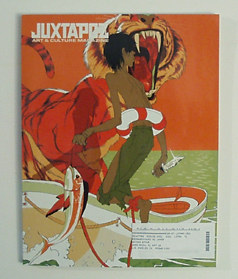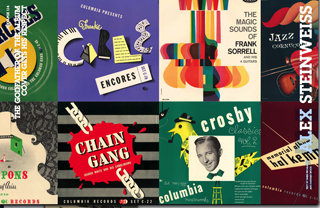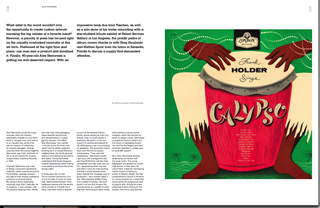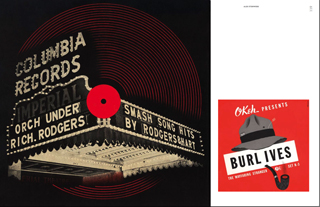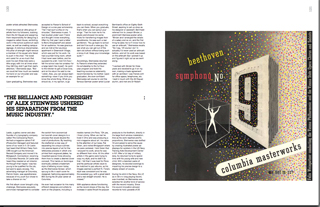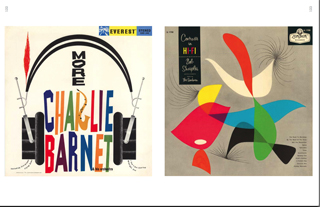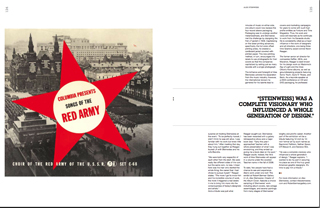
ALEX
STEINWEISS - CREATOR OF THE ALBUM COVER
January 2008 #84
Interviews by Greg Escalante and Nathan Spoor
Story by Nathan Spoor
Alex
Steinweiss' untold legacy has touched an immeasurable number of artists
since he invented the album cover in 1939. This is the story of one man's
inspirational
vision.
Arguably every single artist in the world
would love to be responsible for creating custom artwork to adorn the cover
of a
big release for a favorite band. Yet not much press has been able to shine
a light on the beginnings of the much-overlooked innovator of the art form.
At the right time and place, one man saw a need and was up for the task
- and how. Now, at 90 years of age, Alex Steinweiss is getting his well-deserved
due respects. With an impressive book due from Taschen, and a solo show
of
his works coinciding with an art-star-studded tribute exhibition at Robert
Berman Gallery in Los Angeles, CA, the album cover's prolific padre takes
the time to speak to Greg Escalante and Nathan Spoor about the need that
he created
a solution and inevitably, a demand for.
THE MOTHER OF INVENTION
Alex Steinweiss got into a business that desperately needed him and didn't
even know it yet - the music business. He gave a new outlook to an entire
industry that actually had no immediate direction, and no intention of
having an artistic
flair to its currently plain-packaged fare. This would all change when
a young and insightful Alex was hired, at the tender and unproven age of
23, to be
the Art Director for musical conglomerate Columbia Records in 1939.
Originally, Alex was hired to be the designer for Columbia's advertising
materials. This meant producing the booklets, catalogs, posters, advertisements
and such
for their already impressive collection of musical output. But being
a drone for the corporate ease wasn't his cup of tea. As he puts it, "I was unhappy
with the situation existing there. Mostly with how they were packaging these
beautiful symphonies and orchestrations in crappy generic sleeves." Alex's
father, Max Steinweiss, had instilled in his son a love for the music that
would fuel his artistic epiphany not too much later in life. Having grown up
in their humble Brooklyn, NY surroundings, they would often visit the symphonies
and operas. And Alex knew full well that these were not the bland fare that
the record companies were serving to their public.In those days, records were
12-inch 78 RPMs, and carried only four or five minutes of music on either side.
These were sandwiched between thick cardboard sleeves and had the artists'
names printed on the side, like a book. They were dutifully shelved as such,
with only the spines showing on the General Electric store shelves. GE was
where you paid your electric bill, bought your stove or appliance, and with
no music stores in existence, that was where your record player and select
records were also found. The placement was not ideal, and the returns were
equally as unimpressive."They were like tombstones," Steinweiss rants. "I
got busy with management and said that RCA/Victor was the main competition
and their work was old hat. I approached them with the idea that it could be
more exciting and that it would actually boost the sales, despite the increased
cost of production."And increase the sales it would. Alex was
a favorite of CBS president William Paley, who had created Columbia
and
hired Alex at
the tender age of 23. He believed in him so much that, despite the
fact that they were in the midst of cutting costs and building the
young record
company,
he gave his new concept a trial run. Alex was given five records to
design five covers for. What he brought to the table would change the
record
industry and the history of packaging forever, as his cover design
for the Rogers
and Hart collection brought back a sales jump of some 894 percent!
TASTE FOR MORE
Even as a young child, Alex had shown an amazing connection
with the visual world. He was a student at Lincoln High School in Brooklyn
during the Depression. It was here that Alex met Leon Friend a teacher
and life-long mentor. Leon was noted for being the co-author of a book
that would define the view of graphic designing - the first comprehensive
volume in America on communication art: Graphic Design.Friend was an amazing
teacher that was making use of his scholastic opportunities to truly enrich
these young minds, growing them into individuals that would eventually
use their talents to improve the visual landscape to come. Among the influences
available to them were visiting artists and scholars, with Alex taking
quite strongly to French and German poster artists.There was an elite group
of artists in the school that Friend culled from the pack, making the "Art
Squad". The squad was responsible for designing a magazine called
House, having weekly shows in the auditorium, and creating signs for the
entire campus. Their teacher and mentor was a great disciplinarian as well
as being a pillar of strength, known to kick a student off the Art Squad
for something as minute as not pushing a chair in. "He loved and cared
for us so much that even his own three kids were a little angry with him
at times when they felt they didn't get their dad's attention," says
Alex. "But he could tell how much we needed his hand on our shoulder
and he was an example for us." It was a taste of things to come, and
Leon Friend was instilling his students with all the knowledge and opportunity
that he himself was in tune with.On graduating, Alex was accepted to Parsons
School of Design on a one-year scholarship. "Hah, I had such a chip
on my shoulder," muses Steinweiss, "I had studied under Leon
Friend and thought I knew everything. After my first year, I sent a letter
to Boris Artzybasheff (a precursor to the likes of Robert Williams and
much of the lowbrow esthetic) and asked for an audience. He was gracious,
and we met at his luxurious apartment in Greenwich Village, which was just
for his work. He had a sunken living room, which I'd never seen before,
and he quizzed me a bit and I told him how I felt the school was too amateur
for a large talent like myself. He went to the kitchen to get a Coca Cola
and on his return he said this to me: 'Listen Alex, you can always learn
something even though you think you know the whole thing. What you should
do, in my opinion, is go back to school, accept everything you can there.
When you graduate, that's when you can sprout your wings.' Then he took
me to his studio and showed me some tricks for transferring images from
woodblocks. He was such a real gentleman. 'You go back to school and don't
be such a wise guy. Go see what you can get out of that darn old school
without being such a know-it-all. Keep your knowledge quiet.'
DOWN TO BUSINESS
Sure enough, Alex returned to Parsons and they extended
his scholarship to the full term of his four-year program. He took the
teaching
courses that his mother had been so adamant about and expanded his knowledge
to incorporate as many other aspects of the arts that were available.On graduating,
the very self-confident Alex set a course to visit the famous German poster
artist Lucian Bernhard on 86th street, intending to set up shop as his designer
or assistant. Bernhard met with the young caller and advised him to go see
his friend Joseph Binder, a prominent artist of Viennese poster fame. "Binder
and I arranged the details of salary and so on, and the first thing he asks
me is if I know how to use an airbrush," muses Steinweiss, "so
I say 'Of course I do!', and in actuality I'd never even used an airbrush
before. Oh, and all of his work was based on the airbrush! But I picked it
up and figured it out right as we went along."I worked with Binder for
three years and decided to go it on my own, making a trade agreement with
an architect I was friends with for office space, telephones, etc. I kept
in touch with the Art Squad alumni, and met one Dr. Robert Leslie, a gallery
owner and also founder of a typography company called The Composing Room.
He had a magazine called P-M (Production Manager) and featured some of our
work in it," he recalls. "Dr. Leslie had heard that William Paley
from CBS had bought out the American Record Company and moved it to Bridgeport,
CT, renaming it Columbia Records. Dr. Leslie also heard they needed an art
director. He thought that maybe I was too young to be qualified for the job
but said to apply anyway. Advertising Manager Patrick Dolen, a good Irishman
was apprehensive because of my youth but decided to take a chance on me.
My wife Blanche and I moved to Bridgeport immediately and I got to work designing
things that I actually loved, because they were about the music."And
get to work he did. His first album cover was no easy task. After convincing
the management to consider the switch from cost-effective and boorish cover
designs, (which would easily double the cost of production) he would then
have to create a new way of separating the unique designs into precise layers
of art for the letterpress process (printing from engraved plates). This
meant that Steinweiss had to teach the engravers some special tricks to make
each cover come out as desired, but the effect was nothing short of wondrous.
Alex put real life into each cover he designed for Columbia, turning out
over 800 covers in his 25 year career there, perhaps more. His hands-on technique
even yielded a trademark style of lettering known today as the "Steinweiss
Scrawl." This font was used by many other designers that popped up since
the album art explosion. Due to the success of Alex_s album cover art, other
companies followed suit, and Steinweiss remained the forerunner of the bunch,
always being the artist that the others were constantly measured against.
He
even had occasion to hire many different designers and artists to work on
the projects, including a newbie named Jim Flora (Jux #79). Greg asks him
to elaborate a bit. "Oh yes, I hired Jimmy. When we met he lived in
Ohio and was producing a mini-magazine about art. He came to the attention
of our boss, Pat Dolen, and visited Bridgeport where we were centered. I
told Dolen that I enjoyed his work, since he was so different from mine.
And all the other artists in the game were trying to copy my style, and he
didn't do that. I felt that it was best for Flora and his particular artistic
style to be matched to Jazz albums as his images seemed a perfect fit. Flora_s
style was consistent and he was the sweetest guy, with a great talent and
a real straight shooter. He is missed."World War II changed the way
the records were sold and the degree of exposure they received. As appliance
stores were the main record stores of the day, the increases in sales landed
the records prime choice of the store's real estate - the large front window
installation. And with his work having reached such an incredible rate of
influence, Alex was also called upon for a special duty with the military.
Regardless of his new wife and infant child, Alex was drafted 1A (first,
for us civilians) to serve the cause by creating the illustrated posters
and displays for soldiers in the US Navy Training Aids Development Center,
NY. This he did while still maintaining his work for album covers. On his
return from the 8am - 4pm Navy workout, he returned home for family time
afternoons and evenings of album design. By this time he had a small team
of designers that could implement his direction and flavor with precision.After
the war, Steinweiss was called to another kind of service, again for the
record industry. It seems that during his stint in the Navy, the first LP
(33 rpm long playing record) had been invented. With this innovation in recording,
the records could hold upwards of twenty minutes of music on either side.
This meant that the old packaging of having four records in sleeves for one
album could be replaced by one record. And that meant the packaging norm
was about to go through another growth spurt. Steinweiss was called upon
to design the first LP jacket in 1948, which he created a brilliant solution
for with a cardboard jacket covered with printed paper. (It has been modified
times over, but the same basic Steinweiss design would remain) This in turn
made use of the latest in printing advances, which was the full-color offset
printing press. This new printing method would in turn make easier for labels
to favor the use of photographs for their covers. And the record companies
were finding that they could sell just as many records with a single photograph.
In essence, Alex Steinweiss' brilliance and timely hand had helped to create
another productive venue for him - his retirement from the record industry.
By this point he had reached world renown for his talents, and was creating
covers and campaigns for Fortune and Time magazines, among other high-profile
projects for years to come.
FURTHER
We would be greatly amiss to insinuate that Alex Steinweiss' influence ended
with inventing the album cover. Though his work and voice could be heard
through those avenues, he continues to create from his Sarasota, FL studio.
He is consistently cited as a major influence in the work of designers and
art directors. One such individual is three-time Grammy award winning art
director/designer Kevin Reagan.
Reagan is best known for his Grammy-winning design work on Madonna's "Ray
of Light", "Music", and the Dixie Chicks' "Home" albums,
as well as many other groundbreaking projects featuring Sonic Youth, Guns
'N Roses, Beck and the list goes on and on. Kevin, the former Senior Art
Director for Geffen, MCA and Maverick, was a keynote speaker at a large conference
on CD and DVD packaging in 2003 when he met Steinweiss. "To be perfectly
honest, I didn't think he was still alive. I was familiar with his work but
I knew little about him." After meeting that day the two clicked in
a remarkable way and became fast friends. They hung out the next day as Kevin
showed Alex and his wife Blanche around LA.
"
We were both very respectful of each other from the start. We were really
like different sides of the coin, but the same coin, no less. I mean, here
was the man who started the whole thing; the career that I had chose to pursue
myself," he states. "The more I got to know him and his incredible
volume of work, the more it triggered a real desire in me to bring him more
into the consciousness of today's designers and artists. Alex is a complete
visionary who influenced a whole generation of design. I wanted to do my
part in securing his place as one of the truly great American graphic designers.
It was time to pay him a tribute.”
And a tribute was just what Kevin sought out. Steinweiss has since been rewarded
with a gallery retrospective show and a major book deal. "Early this
year I approached Taschen Books, my first choice, with a whole presentation
of what I was envisioning and they ended up giving us a book deal on the
spot," he exclaims. "I was hoping they would get it, and they did".
Indeed, the life's work of Alex Steinweiss will appear in a volume under
the coveted Taschen name in the Fall of 2008.
To date, few people have had a chance to see and experience Alex's work under
one roof. Kevin Reagan and Greg Escalante have spear headed the motion to
find a worthy venue, securing the esteemed Robert Berman Gallery in Bergamot
Station. This exhibit will boast an incredible offering in a show titled:
Alex Steinweiss - Creator of the Album Cover. The exhibition will feature
a choice sampling of his work including album covers, rare collage assemblages
and several paintings from many stages of Steinweiss' lengthy and prolific
career.
A part of this exhibition will be a tribute show featuring art on 12 x 12" format
by such names as Shag, Miles Thompson, Andrew Brandau, Lola, Raymond Pettibon,
Josh Petker, Nathan Spoor, Tamara Guion, Jim Woodring, Cameron Gray, Glen
Wexler, Thomas Woodruff, Craig Stecyk, Sergio Aragones, and Sandow Birk.
(with more artist still to confirm)
This unique show at Robert Berman Gallery's opens at the same time as an
exhibition by L.A._s Seventh Letter, in Berman_s other gallery across the
yard in the same Bergamot / Santa Monica location. This cultural testament
in triplicate goes on view to the public the night of Saturday, January 19,
2008, and is surely set to leave a monumental imprint in the spectrum of
Steinweiss' history of influence.
